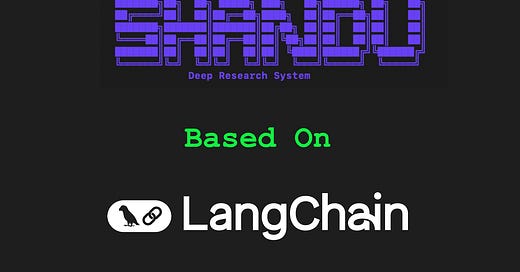Search 2.0
Shandu is a powerful open-source AI research tool that streamlines the discovery and synthesis of knowledge.
Hosted at https://github.com/jolovicdev/shandu, Shandu can be used an innovative alternative to proprietary systems like OpenAI’s DeepResearch, leveraging LangChain and LangGraph to automate comprehensive, multi-source research.
This article I briefly look at Shandu’s LangChain foundation, its place among other LangChain-powered tools, and how it shows the shift from traditional search (Search 1.0) to a new era of AI-driven answers (Search 2.0).
Shandu’s LangChain Foundation
LangChain — a framework for developing LLM-powered applications — and LangGraph — a library for creating stateful workflows — Shandu automates the entire research process, from query clarification to generating structured Markdown reports with full citations.
Significant LangChain-Based Tools
Shandu is part of a expanding ecosystem of tools powered by LangChain. Here are five notable examples:
Here’s a list of projects that are built on or heavily utilize LangChain:
Shandu — A tool for creating interactive conversational agents using LangChain’s framework
Quivr — An open-source second brain that uses LangChain for document processing and RAG capabilities
LangFlow — A UI for LangChain, allowing visual creation and experimentation with LangChain components
Flowise — A drag-and-drop UI builder specifically for creating LangChain flows
Langroid — A framework for multi-agent collaboration built on top of LangChain
Camel — A communicative agent framework that leverages LangChain for agent functionality
ChatDev — A framework for software development via multi-agent collaboration using LangChain
Chainlit — A tool for building conversational AI interfaces with LangChain integrations
GPTRouter — A system for routing queries to different LLM endpoints using LangChain
BentoML — While not entirely built on LangChain, it offers strong LangChain integrations for serving LLM applications
PrivateGPT — A document QA system that uses LangChain for document processing and querying
Auto-GPT — An early autonomous agent framework that incorporated LangChain components
How LangChain Acts as a Flywheel
LangChain acts as an accelerator for other technologies by providing a unified framework for LLM orchestration, reducing development time.
Its modular components — chains, agents and more — enable rapid prototyping and iteration.
Integration with external APIs and data sources enhances functionality, while the open-source community drives continuous improvement.
As seen in the image above, this flywheel effect amplifies innovation, making tools like Shandu more powerful and accessible.
From Search 1.0 to Search 2.0
The evolution from Search 1.0 to Search 2.0 marks a paradigm shift in how we access information.
In the era of Search 1.0, users faced a deluge of sponsored links, SEO-optimized noise, and irrelevant results. Finding answers required sifting through pages, opening multiple tabs, reading disparate sources, and manually synthesizing insights — a time-consuming and error-prone process.
Search 2.0, embodied by tools like Shandu, transforms this experience.
Instead of raw search results, Shandu retrieves, synthesizes, and formats data into consumable outputs, such as cited Markdown reports. By leveraging LLMs and intelligent scraping, it navigates dynamic web content, evaluates source credibility, and delivers structured insights tailored to user needs.
For example, a command like shandu research "Quantum Computing and Climate Modeling" --depth 3 --output report.md generates a comprehensive report in minutes, bypassing the manual labor of traditional search.
This shift democratizes research, making it faster and more accessible. However, Search 2.0 tools must address challenges like bias in LLMs, source reliability, and scalability to fully realize their potential.
Conclusion
Shandu exemplifies the power of LangChain in building open-source tools that redefine research. By automating the journey from query to insight, it stands alongside other LangChain-driven innovations in pushing the boundaries of AI.
As we transition from Search 1.0’s fragmented results to Search 2.0’s synthesised answers, tools like Shandu is a view into a future where knowledge is not just found but crafted with precision and efficiency.
Chief Evangelist @ Kore.ai | I’m passionate about exploring the intersection of AI and language. From Language Models, AI Agents to Agentic Applications, Development Frameworks & Data-Centric Productivity Tools, I share insights and ideas on how these technologies are shaping the future.






